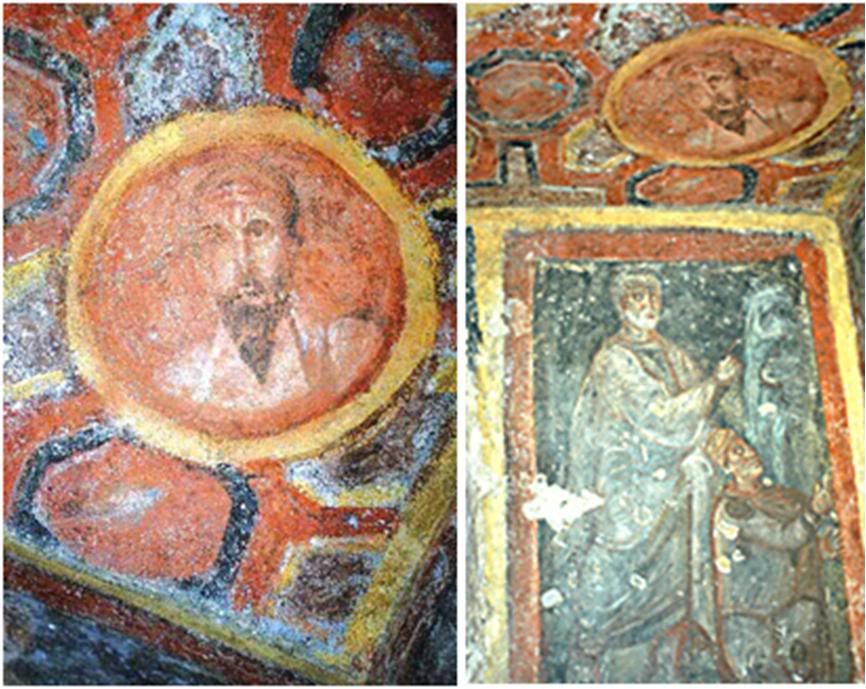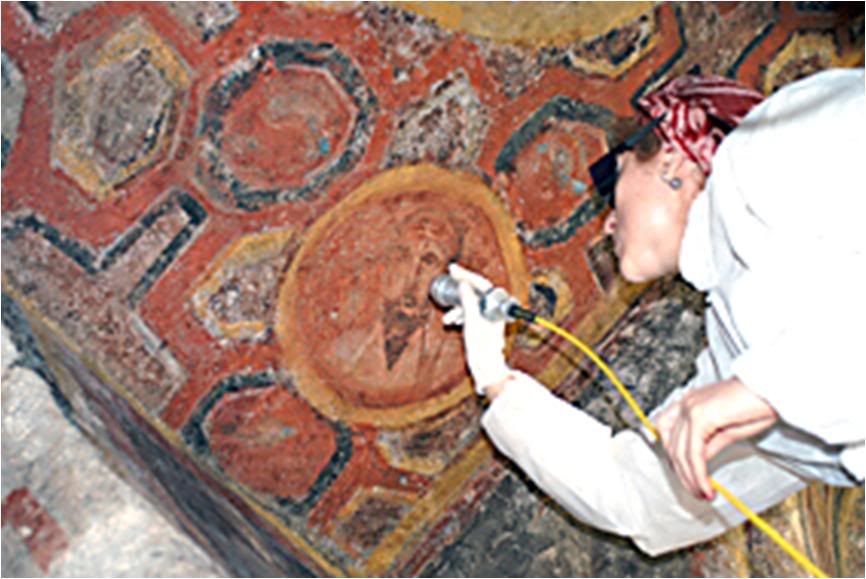 It's hard not to consider this event providential in every way. For the discovery to be made just before the Pauline Year closes, for the image to be in such good condition over a distance of 16 centuries, merely adds to the indescribable thrill one feels before a major archaeological find. And this one is prime major.....
It's hard not to consider this event providential in every way. For the discovery to be made just before the Pauline Year closes, for the image to be in such good condition over a distance of 16 centuries, merely adds to the indescribable thrill one feels before a major archaeological find. And this one is prime major.....
L'Osservatore Romano has a couple of longish articles about the find in today's issue, but for now I will use a story from the Italian secular press based on those articles because it is shorter.
Roman archaeologists find
oldest known image of St. Paul
in a Roman catacomb
by Giacomo Galeazzi
Translated from

June 28, 2009



Vatican archaeologists have discovered a portrait of the Apostle Paul in the catacombs of St. Tecla.
L'Osservatore Romano today unveiled the oldest known image of the saint, described as 'a sensational find which has impressed experts'.
The archaeologists found the valuable portrait on June 19 during restoration of frescoes decorating a small cubicle in the catacombs on Rome's via Ostiense, just a few hundred meters distant from the basilica of St. Paul outside the Walls, which was erected on the site where Paul was buried and houses his tomb.
The frescoes date to the end of the fourth century, making this portrait of Paul the oldest known pictorial representation of the Apostle to the Gentiles.
Working with laser tools, the archaeologists from the Pontifical Commission for Sacred Archeology uncovered 'the severe and easily recognizable face of St. Paul".
The Vatican paper describes the bust portrait as "a marvel of suggestive expression which left the restorers breathless, interrupting their work in awe of that face which, emerging from the obscurity of the catacomb, strikes and moves whoever looks at it."
Archeological experts from the Vatican museums rushed to the site to verify 'the extraordinary importance of the discovery' which led the Vatican to announce the news almost immediately, despite the fact that restoration of the cubicle is still underway.
[What the Stampa article does not mention is that the circular portrait of Paul is one of four similar 'tondos' on the ceiling fresco whose central figure is the Good Shepherd, and that one of the four portraits clearly depicts St. Peter. The other two have not been conclusively identified but it is thought they represent the Apostles John and James the Elder.]
"A lucky and surprising discovery from a the 'submerged world' of dark catacombs, tunnels and cubicles miraculously preserved from obliteration," exults Archbishop Gianfranco Ravasi, president of teh Pontifical Commission for Culture.
"It is an eloquent testimony of Christianity in the early centuries, marking a a new and extraordinary chapter in the history of Christian art in late antiquity."
Recent studies have overturned many stereotypes about the person of the man who has been called 'the inventor of Christianity' [
a disparaging appellation by anti-Christian scholars who imply that St. Paul 'invented' the major features of the story of Christ].
The most recent researches, for instance by Fr. Cesare Atuire, belie the image of Paul as the warrior for God who was robust and powerful as many imagined due to his many perilous missions, but was in fact,
irascible, short, bald, slightly hunchbacked and probably an epileptic.
That in fact, the human features cloaking the interior spirituality of St. Paul show him to be some one who was simply 'one of us'.
Fr. Atuire has been doing on-site research in the places associated with St. Paul, from Syria to Turkey to Malta and Cyprus, adn then to Rome, and is naturally ecstatic about the sensational find.
"It is an image that speaks to man today, that in order to imitate St. Paul, one must find his humanity, as a man with so many disadvantages. This portrait depicts a man who, with all his physical defects, succeeded to embody the Christian message."
"Significantly," he continues, the early Christians responsible for this portrait chose not to prettify him, because to present him with all his physical disadvantages makes him a more valuable model to follow. He was a man who lived in himself the contradictions of his time, with very human attitudes which make us feel him close to us and not distant as many saints often make us feel."
Speaking of Paul's experience on the road to Damascus, the priest says: "The lightning bolt and his fall from the horse on the road to Damascus was the moment of Paul's vocation - when he was called by Christ - and not of his conversion, which was a much longer and slower process. Paul's experience shows that God's call can come to everyone, even those who are in a state of sin. God does not address himself only to people who are already holy."
Mons. Ravasi says, "There is a great theological and spiritual value to this find, besides its historical and artistic merit. The presence of the image of St. Peter in the same fresco is additional and important proof of the
concordia apostolorum [perfect apostolic harmony] which was at the heart of the religious notion of the Roman Church in the second half of the fourth century".
Day after day, the restorers are "uncovering depictions of Biblical stories and faces of the apostles through which ideas, programs and new projects for the faith were conveyed in pictorial form," he notes.
Paul's face, surrounded by a yellow-gold round frame on a background of red, "moves us by its stark expressionism, a strong and eloquent icon of the Apostle, a face of his time, which reminds us of that mission which the Church of Rome, in the 3rd and 4th centuries, carried out in the name of Paul in order to convert the last of the pagans to Christianity".
As for Paul's tomb, located under the main altar of St. Paul's Basilica outside the Walls, the Archpriest of the Basilica, Cardinal Andrea Cordero Lanza di Montezemolo, said the other day that there has been no decision yet to open the tomb.
He said the decision would be made by the Pope, since it would involve major steps such as deconstructing the present main altar. Attempts to inspect the interior non-invasively by X-ray have failed, he said because the sarcophagus walls are 25 centimeters thick.
[Modificato da TERESA BENEDETTA 29/06/2009 00:32]